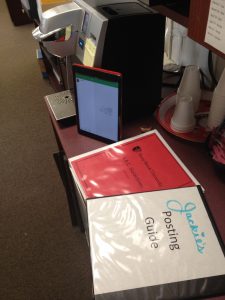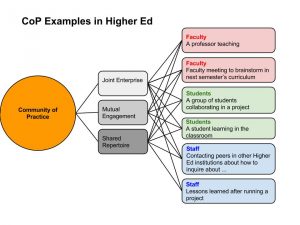This week’s reading, Wenger, “Community” from Communities of Practice, is, as many of my colleagues have already pointed out, a fairly hefty article. It took a bit longer for me to read which I believe is partially due to the fact that I attempted to only read on the iPad, and I do not currently know how to highlight or whatnot like during my usual note taking.
This is the second chapter of his book, and Wenger often references chapter one. It might have been helpful to have that knowledge, but wasn’t entirely essential. To my own understanding,
Wenger describes a community of practice on a few different levels. I best equate each of these levels (or at times it could be better understood as a concept or other similar thought-model/pattern) with my job.
I work in Academic and Transfer Advising Services at Stony Brook University. We handle academic advising for all transfer students and continuing students after their freshman year. Take for instance, this picture:
At my work, our practice is helping students academically through transfer articulation and advising. We have decided to come together to develop this practice. We have formed a “process” which is reflected in the Red-Covered binder. It has all of the policies and regulations. “Jackie’s Posting Guide” represents each employee’s own contribution to these practices: We all have a specialty. We come from different backgrounds with different experience.
This “contribution” is not only expressed via policies, but also through simple “water cooler conversation.” In our case, it is the office Keurig! Employees talk relationships, the weather, general gossip; they laugh and cry together; parties are celebrated together. Each of these contribute to the overall atmosphere of the community.
Wenger was also adamant to point out that communities of practice are not limited to a particular office, building, or even country. To represent this, I opened Google Hangouts on my iPad Air. Although you cannot see the name, it is actually a colleague that I have done much work with via Hangouts.
If you have read Wenger’s chapter, you may notice that I chose to not use much of his terminology. Frankly, I found it to be a bit excessive. Of course, I plan on delving into this matter further, but I believe that these things can be said much more simply than his terms: Mutual Engagement, Joint Enterprise, and Shared Repertoire.
I am curious to know other “simple” examples of this idea. I’m sure that it can be used in education, and I think that MOOCs (Massive Open Online Courses) are possibly heading toward this idea of a “shared” repertory of knowledge. However, I wonder how classrooms can more immediately begin to transition to this style of learning. I personally enjoy Wenger’s thoughts and believe that it is indeed part of what can help the education system.
Question is…is there a middle ground between MOOCs and the classroom? CDT 450 seems to be on the right track, but are there other possible ways? I’d love to hear from you in the comments below. What are your ideas?
Technically Yours,
R.

